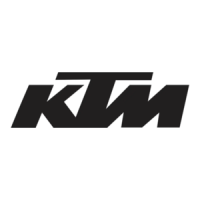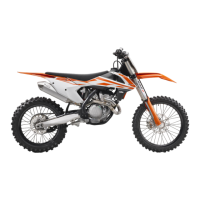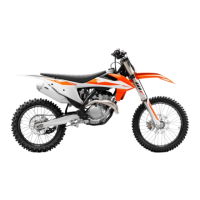CLEANING, CARE 80
17.1Cleaning the motorcycle
Note
Material damage Damage and destruction of components by high-pressure cleaning equipment.
– Never clean the vehicle with high-pressure cleaning equipment or a strong water-jet. The excessive pressure can penetrate electri-
cal components, socket connects, throttle cables, and bearings, etc., and can damage or destroy these parts.
Warning
Environmental hazard Hazardous substances cause environmental damage.
– Oil, grease, filters, fuel, cleaners, brake fluid, etc., should be disposed of as stipulated in applicable regulations.
Info
If you clean the motorcycle regularly, its value and appearance will be maintained over a long period.
Avoid direct sunshine on the motorcycle during cleaning.
401061-01
– Close off the exhaust system to keep water from entering.
– First remove coarse dirt particles with a gentle spray of water.
– Spray very dirty areas with a normal motorcycle cleaner and then clean with a
paintbrush.
Motorcycle cleaner ( p. 98)
Info
Use warm water containing normal motorcycle cleaner and a soft sponge.
– After rinsing the motorcycle with a gentle spray of water, allow it to dry thoroughly.
Warning
Danger of accidents Reduced braking efficiency due to wet or dirty brakes.
– Clean or dry dirty or wet brakes by riding and braking gently.
– After cleaning, ride a short distance until the engine reaches operating tempera-
ture.
Info
The heat produced causes water at inaccessible locations in the engine and
the brakes to evaporate.
– Push back the protection caps of the handlebar controls to allow any water that has
penetrated to evaporate.
– After the motorcycle has cooled off, lubricate all moving parts and bearings.
– Clean the chain. ( p. 47)
– Treat bare metal parts (except for brake discs and the exhaust system) with a corro-
sion inhibitor.
Cleaning and preserving materials for metal, rubber and plastic ( p. 98)
– Treat all plastic parts and powder-coated parts with a mild cleaning and care agent.
Paint cleaner and polish for high-gloss and matte finishes, bare metal and plastic
surfaces ( p. 99)

